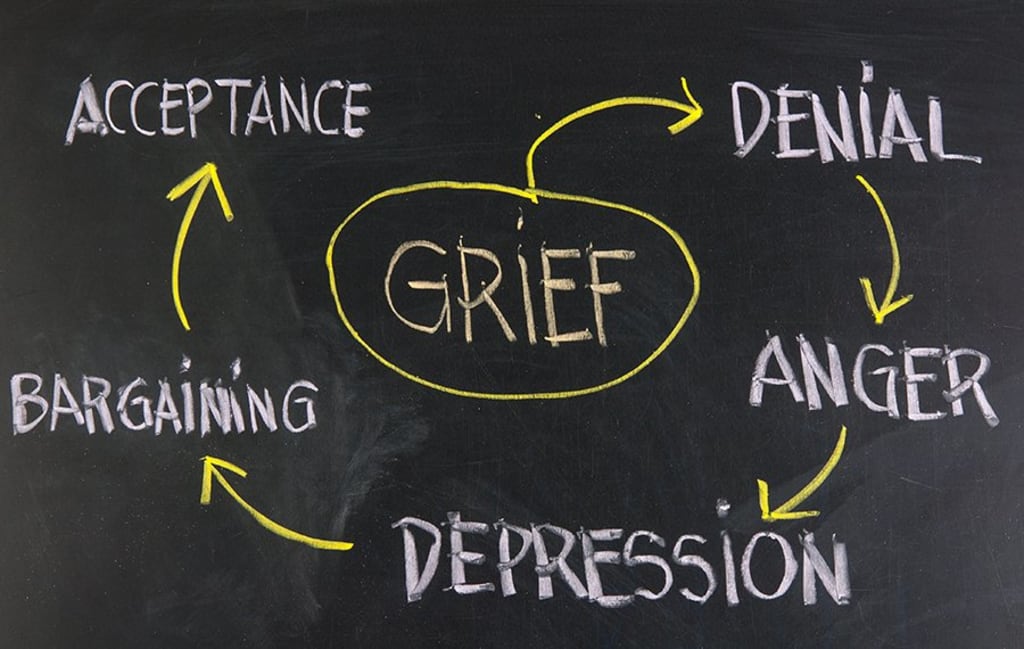The Five Stages of Grief
In this essay I wrote for my Psychology course in college, I explain the main achievement of Elizabeth Kubler Ross.

Kubler-Ross
Elizabeth Kubler-Ross massively contributed to the world of psychology. Her most important work is named, the Five Stages of Grief, and was originally designed to help terminally ill patients cope with their certain death. This theory has a set of patterns that explain what people go through after a dramatic event. Many professionals implement the stages of grief to their patients and even themselves. In some cultures, this theory does not apply because they already have another way to look at death when this pattern in applied in a terminal disease setting. This theory can still be generalized and be applied to different situations in order to analyze behavioral changes in people and employees.
Ross first developed her theory in the book, On Death and Dying, in 1969, and as the name says it, contains five stages. The first stage of grief is denial. In this stage, the person has just recently faced something unbelievable and cannot yet fathom the situation. They generally tend to ask many questions to themselves and try to find ways to assure themselves of the situation. This stage is then followed by anger.
In the anger stage, mostly religious people start to question their beliefs. Asking God why this had to happen to them and so forth. Kubler mentions, “You think, maybe God is mad at me and this is what I get for being mad at him.” Statements like these sometimes lead to the person to lose their religion. People tend to distant themselves and try to find ways to compensate in order to fill the hole they are in; but the ones that remain faithful mostly pray for things to get better. Which leads to the next stage.
The following stage is bargain, they start to think about how they should have done something differently or have not made a person do something that led them to an unwanted fate. In her book, On Grief and Grieving, Kubler says, “We become lost in a maze of “if only . . .” or “What if . . .” statements.” Bargaining is at first a form of relieve. People start thinking about the situation, and they learn that doing stuff differently in the future will avoid situations like the one they are in. Unfortunately, after a while they start to realize it is worthless to think about the past, and soon feelings of helplessness begin to set in.
Depression is the fourth stage in the Five Stages of Grief, and it can be heavy on some people. They start to fall deep in their grief and begin to withdraw a little from real life depending on the person. Sadness and emptiness are some of the feelings people experience. Finally, the last stage is Acceptance. In this stage, some people have found the relieve they needed and feel a little better about themselves. Others usually still are grieving and have not fully healed but feel a sense of acceptance of the situation. Fully they have comprehended the life changing matter but are not as psychologically healthy as they were.
This theory has been applied to many ways of life and different psychological situations. In an article, Resident Work Hours: The Five Stages of Grief, published by medicine doctors James E. Barone and Michael E. Ivy (2004), they applied the Five Stages of Greif to the Accreditation Council for Graduate Medical Education. They basically wanted to reduce resident work hours because some workers feel the hours of work are too much. They wanted to highlight a pattern most of the workers went through when the new mandate was in place. Through the Five Stages of Greif they recorded what most of them dealt with and most of them in the last stage either were fully complying and or some to an extent. The most important factor is that this pattern even applied to the authors of the article and how they themselves handled the stages while they tried to help their workers cope with their own stages.
Some professionals agree and implement this theory and support it. Authors Samuel Wood, Ellen Wood, and Denise Boyd wrote in their book, Mastering the World of Psychology (2017), that this theory helps a lot with patients that are terminally ill. They mention that people sometimes have the option to be euthanized so they will not suffer as much. “Mercy killing” and “assisted suicide” are some of the options these patients have in order for them to die peacefully and just get it over with. They have even created “hospice care” which is basically when the patient is at home but on the process of dying. They follow specific guidelines for the process to be completed.
The Five Stages of Grief could not work in all cultures as the previous authors mention that in some cultures, death is basically normal and try to face it with courage. In some western countries, death is seen as a very bad thing and even as an opponent towards a person. Mexico is a great in coping with death. Not using the stages of grief, but they implement another system that makes the person feel like it is just another stage in life. Dia de los Muertos in Mexico is a tradition that celebrates the dead and is meant to encourage people not to fear it.
This theory can be generalized in different ways. Author Weng Marc Lim presented in the article, Revisiting Kubler-Ross’s Five Stages of Grief: Some comments on the iPhone 5 (2013), in which Apple buyers faced the Five Stages of Grief when they bought the iPhone 5 the day of its release. He expressed that at first people were excited for the new product but as soon as the got their hands in the new gadget, they were let down. In their acceptance stage, Lim says that finally they accept the product as is but are awaiting to commit the same mistake again the next time Apple releases a new iPhone.
The Five Stages of Grief was used to determine the reaction of nuclear plant workers in Germany after they were informed that the country will soon begin to switch to renewable energy. This action came after the country decided to take safety measures following the nuclear accident that happened in Japan. German authors Elmar Friedrich and Rolf Wüstenhagen mentioned in their article, Leading Organizations Through the Stages of Grief: The Development of Negative Emotions Over Environmental Change, that nuclear plant workers did not believe at first that the country was going to switch their policies. They studied their behavior through Kubler-Ross’s model and determined that workers were having trouble coping with the regulations. They found out how these changes greatly affect workers, but ultimately after some time the faculty evolves. This model helps big companies analyze the reaction of their employees to new mandates, and they can further create more time to help them cope with these issues.
Kubler-Ross’s Five Stages of Greif emotional adaptive pattern has proven to be helpful to people that are terminally ill. Many professionals use this pattern in hospitals for people and even implement it on themselves when facing situations that affect them. Depending on the gravity of the culture, the Five Stages of Grief cannot be applied because in some cultures they either see death as a very holy thing, and in others they see death as an enemy and a weakness in one self. Companies can use the grief stages in order to analyze the emotions their employees reflect due to new mandates, which leads them to better help them cope and gather information to further serve their employees and customers.
References
Kübler-Ross, E., & Kessler, D. (2005). On grief and grieving: Finding the meaning of grief through the five stages of loss. Simon and Schuster. https://books.google.com/books?hl=en&lr=&id=0TltiT8Y9CYC&oi=fnd&pg=PR11&dq=kubler+ross+stages+of+grief&ots=S1aWYAO92U&sig=eu9tjGRPFF2ILySSN5HR_f5CL5s#v=onepage&q=kubler%20ross%20stages%20of%20grief&f=false
Barone, James E., MD; Ivy, Michael E., MD. Resident Work Hours: The Five Stages of Grief, Academic Medicine: May 2004 - Volume 79 - Issue 5 - p 379-380https://journals.lww.com/academicmedicine/Fulltext/2004/05000/Resident_Work_Hours_The_Five_Stages_of_Grief.2.aspx
Wood, Samuel E., Wood, Ellen Green, Boyd, Denise. (2017). Mastering the World of Psychology: A Scientist-Practitioner Approach -- Books a la Carte (6th Edition). Chapter 8.6.4. https://revel-ise.pearson.com/courses/5f604b0114cb3c001a55db52/pages/urn:pearson:entity:0d03258f-10c5-480c-9908-55b1a9a11692?source=contents.
Lim, Weng M. (2013). REVISITING KUBLER-ROSS’S FIVE STAGES OF GRIEF: SOME COMMENTS ON THE IPHONE 5. http://citeseerx.ist.psu.edu/viewdoc/download?doi=10.1.1.974.2063&rep=rep1&type=pdf.
Friedrich, E., & Wüstenhagen, R. (2017). Leading Organizations Through the Stages of Grief: The Development of Negative Emotions Over Environmental Change. Business & Society, 56(2), 186–213. https://journals.sagepub.com/doi/full/10.1177/0007650315576151?casa_token=Gpk1BwPi_90AAAAA%3ARdUo0KQCtQIQu7ml_3l3GZpTVnJFAh_V8m3oJwBaPBD52NQ03ImYn8vBSZBiHAvMJDo1GnYeWxWp5g#articleCitationDownloadContainer.
About the Creator
Alan De La Torre
I'm a young college student looking to publish my work on this platform. From being at work to adventures with friends, to advice and life tips that I believe will help ordinary people like me cope with life. One word at a time.






Comments
There are no comments for this story
Be the first to respond and start the conversation.